Development of Conductive Mortar for Efficient Sacrificial Anode Cathodic Protection of Reinforced Concrete Structures—Part 2: Four-Year Performance Evaluation in Bridges
Abstract
:1. Introduction
2. Bridge Structure
3. Corrosion Evaluation
4. Methods
4.1. Conductive Mortar Material
4.2. Basic Property Tests of Conductive Mortar
4.3. Installation of SACP System to the Bridge Pier
5. Results and Discussions
5.1. Basic Property Test
5.2. Depolarization Potential Measurement
6. Conclusions
- The conductive mortar satisfied the criteria for basic property tests. Although both the compressive and flexural strengths results measured up to 28 days tended to decrease with increasing admixture amounts, the test results ensured satisfactory quality for on-site construction for all proposed amounts of activated carbon. The conductive mortar demonstrated both basic properties and durability and secured effective performance for the intended application.
- Through depolarization potential measurements, although the performance of SACP decreased slightly with time, SACP with conductive mortar showed superior performance to that with general mortar. Some partial protection was observed after four years; however, this does not mean that it is not protected at all. This is not thought to be a problem because the amount of depolarization can be changed depending on the specific resistivity of the concrete, such as rain, humidity, and weather.
- Visual inspection of the test specimens with the CP system revealed no corrosion after four years, whereas significant corrosion was observed in the unprotected specimens. This additional confirmation indicates that the CP system operated well, even if there were some possibilities of partial protection in some columns.
Author Contributions
Funding
Institutional Review Board Statement
Informed Consent Statement
Data Availability Statement
Conflicts of Interest
References
- Byrne, A.; Holmes, N.; Norton, B. State-of-the-art review of cathodic protection for reinforced concrete structures. Mag. Concr. Res. 2016, 68, 664–677. [Google Scholar] [CrossRef]
- Zhou, Y.; Gencturk, B.; Willam, K.; Attar, A. Carbonation-induced and chloride-induced corrosion in reinforced concrete structures. J. Mater. Civ. Eng. 2015, 27, 04014245. [Google Scholar] [CrossRef]
- Page, C. Mechanism of corrosion protection in reinforced concrete marine structures. Nature 1975, 258, 514–515. [Google Scholar] [CrossRef]
- Jeong, J.-A.; Jin, C.-K.; Kim, Y.-H.; Chung, W.-S. Electrochemical performance evaluation of corrosion monitoring sensor for reinforced concrete structures. J. Adv. Concr. Technol. 2013, 11, 1–6. [Google Scholar] [CrossRef]
- Erdogan, C.; Swain, G. Conceptual sacrificial anode cathodic protection design for offshore wind monopiles. Ocean Eng. 2021, 235, 109339. [Google Scholar] [CrossRef]
- Jeong, J.-A.; Jin, C.-K. The effect of temperature and relative humidity on concrete slab specimens with impressed current cathodic protection system. J. Adv. Mar. Eng. Technol. (JAMET) 2013, 37, 260–265. [Google Scholar] [CrossRef]
- Erdogan, C.; Swain, G. The effects of biofouling and corrosion products on impressed current cathodic protection system design for offshore monopile foundations. J. Mar. Sci. Eng. 2022, 10, 1670. [Google Scholar] [CrossRef]
- Zhou, H.; Xu, Y.; Peng, Y.; Liang, X.; Li, D.; Xing, F. Partially corroded reinforced concrete piers under axial compression and cyclic loading: An experimental study. Eng. Struct. 2020, 203, 109880. [Google Scholar] [CrossRef]
- Guo, A.; Li, H.; Ba, X.; Guan, X.; Li, H. Experimental investigation on the cyclic performance of reinforced concrete piers with chloride-induced corrosion in marine environment. Eng. Struct. 2015, 105, 1–11. [Google Scholar] [CrossRef]
- Yuan, W.; Guo, A.; Li, H. Experimental investigation on the cyclic behaviors of corroded coastal bridge piers with transfer of plastic hinge due to non-uniform corrosion. Soil Dyn. Earthq. Eng. 2017, 102, 112–123. [Google Scholar] [CrossRef]
- Schmitt, G.; Schütze, M.; Hays, G.F.; Burns, W. Global needs for knowledge dissemination, research, and development in materials deterioration and corrosion control. World Corros. Organ. 2009, 38, 14. [Google Scholar]
- Koch, G. Cost of corrosion. In Trends in Oil and Gas Corrosion Research and Technologies; Elsevier: Amsterdam, The Netherlands, 2017; Volume 2017, pp. 3–30. [Google Scholar]
- Pedeferri, P. Cathodic protection and cathodic prevention. Constr. Build. Mater. 1996, 10, 391–402. [Google Scholar] [CrossRef]
- de Rincon, O.T.; Hernández-López, Y.; de Valle-Moreno, A.; Torres-Acosta, A.A.; Barrios, F.; Montero, P.; Oidor-Salinas, P.; Montero, J.R. Environmental influence on point anodes performance in reinforced concrete. Constr. Build. Mater. 2008, 22, 494–503. [Google Scholar] [CrossRef]
- Christodoulou, C.; Glass, G.; Webb, J.; Austin, S.; Goodier, C. Assessing the long term benefits of Impressed Current Cathodic Protection. Corros. Sci. 2010, 52, 2671–2679. [Google Scholar] [CrossRef]
- Cheng, X.; Xia, J.; Wu, R.-J.; Jin, W.-L.; Pan, C.-G. Optimisation of sacrificial anode cathodic protection system in chloride-contaminated reinforced concrete structure. J. Build. Eng. 2022, 45, 103515. [Google Scholar] [CrossRef]
- Van Belleghem, B.; Maes, M.; Soetens, T. Throwing power and service life of galvanic cathodic protection with embedded discrete anodes for steel reinforcement in chloride contaminated concrete. Constr. Build. Mater. 2021, 310, 125187. [Google Scholar] [CrossRef]
- Bertolini, L.; Redaelli, E. Throwing power of cathodic prevention applied by means of sacrificial anodes to partially submerged marine reinforced concrete piles: Results of numerical simulations. Corros. Sci. 2009, 51, 2218–2230. [Google Scholar] [CrossRef]
- Bertolini, L.; Gastaldi, M.; Pedeferri, M.; Redaelli, E. Prevention of steel corrosion in concrete exposed to seawater with submerged sacrificial anodes. Corros. Sci. 2002, 44, 1497–1513. [Google Scholar] [CrossRef]
- Kranc, S.; Sagues, A.A.; Presuel-Moreno, F.J. Computational and experimental investigation of cathodic protection distribution in reinforced concrete marine piling. In Proceedings of the Corrosion97; NACE International: Houston, TX, USA, 1997. [Google Scholar]
- Presuel-Moreno, F.; Kranc, S.; Sagues, A. Cathodic prevention distribution in partially submerged reinforced concrete. Corrosion 2005, 61, 548–558. [Google Scholar] [CrossRef]
- Jeong, J.-A.; Jin, C.-K.; Chung, W.-S. Tidal water effect on the hybrid cathodic protection systems for marine concrete structures. J. Adv. Concr. Technol. 2012, 10, 389–394. [Google Scholar] [CrossRef]
- Jeong, J.; Jin, C. Experimental studies of effectiveness of hybrid cathodic protection system on the steel in concrete. Sci. Adv. Mater. 2014, 6, 2165–2170. [Google Scholar] [CrossRef]
- García, Á.; Schlangen, E.; van de Ven, M.; Liu, Q. Electrical conductivity of asphalt mortar containing conductive fibers and fillers. Constr. Build. Mater. 2009, 23, 3175–3181. [Google Scholar] [CrossRef]
- Fu, X.; Chung, D. Carbon fiber reinforced mortar as an electrical contact material for cathodic protection. Cem. Concr. Res. 1995, 25, 689–694. [Google Scholar] [CrossRef]
- Hou, J.; Chung, D. Cathodic protection of steel reinforced concrete facilitated by using carbon fiber reinforced mortar or concrete. Cem. Concr. Res. 1997, 27, 649–656. [Google Scholar] [CrossRef]
- Bertolini, L.; Bolzoni, F.; Pastore, T.; Pedeferri, P. Effectiveness of a conductive cementitious mortar anode for cathodic protection of steel in concrete. Cem. Concr. Res. 2004, 34, 681–694. [Google Scholar] [CrossRef]
- Xu, J.; Yao, W. Current distribution in reinforced concrete cathodic protection system with conductive mortar overlay anode. Constr. Build. Mater. 2009, 23, 2220–2226. [Google Scholar] [CrossRef]
- Jing, X.; Wu, Y. Electrochemical studies on the performance of conductive overlay material in cathodic protection of reinforced concrete. Constr. Build. Mater. 2011, 25, 2655–2662. [Google Scholar] [CrossRef]
- Carmona, J.; Garcés, P.; Climent, M. Efficiency of a conductive cement-based anodic system for the application of cathodic protection, cathodic prevention and electrochemical chloride extraction to control corrosion in reinforced concrete structures. Corros. Sci. 2015, 96, 102–111. [Google Scholar] [CrossRef]
- Zhao, R.; Tuan, C.; Xu, A.; Fan, D. Conductivity of ionically-conductive mortar under repetitive electrical heating. Constr. Build. Mater. 2018, 173, 730–739. [Google Scholar] [CrossRef]
- Seo, D.-J.; Lee, Y.-J.; Choi, B.-G.; Park, J.-G.; Heo, G.-H. Study on Heating Performance and Flexural Strength Properties of Electrically Conductive Mortar. Appl. Sci. 2023, 13, 9903. [Google Scholar] [CrossRef]
- Ha, J.-M.; Jeong, J.-A.; Jin, C. Development of Conductive Mortar for Efficient Sacrificial Anode Cathodic Protection of Reinforced Concrete Structures—Part 1: Laboratory Experiments. Appl. Sci. 2022, 12, 12056. [Google Scholar] [CrossRef]
- KS F 4042; Polymer Modified Cement Mortar for Maintenance in Concrete Structure. KSA: Seoul, Republic of Korea, 2017.
- Mercuri, M.; Vailati, M.; Gregori, A. Lime-based mortar reinforced with randomly oriented polyvinyl-alcohol (PVA) fibers for strengthening historical masonry structures. Dev. Built Environ. 2023, 14, 100152. [Google Scholar] [CrossRef]
- NACE RP 0290-90; Cathodic Protection of Reinforced Steel in Concrete Structure. NACE: Houston, TX, USA, 1990.
- ASTM C876-15; Standard Test Method for Corrosion Potentials of Uncoated Reinforcing Steel in Concrete. ASTM International: West Conshohocken, PA, USA, 2015.
- ASTM G5-14; Standard Reference Test Method for Making Potentiodynamic Anodic Polarization Measurements. ASTM International: West Conshohocken, PA, USA, 2014.
- ACI Committee 222; C.o.M.i.C. Protection of Metals in Concrete Against Corrosion. ACI: Washington, DC, USA, 2001.
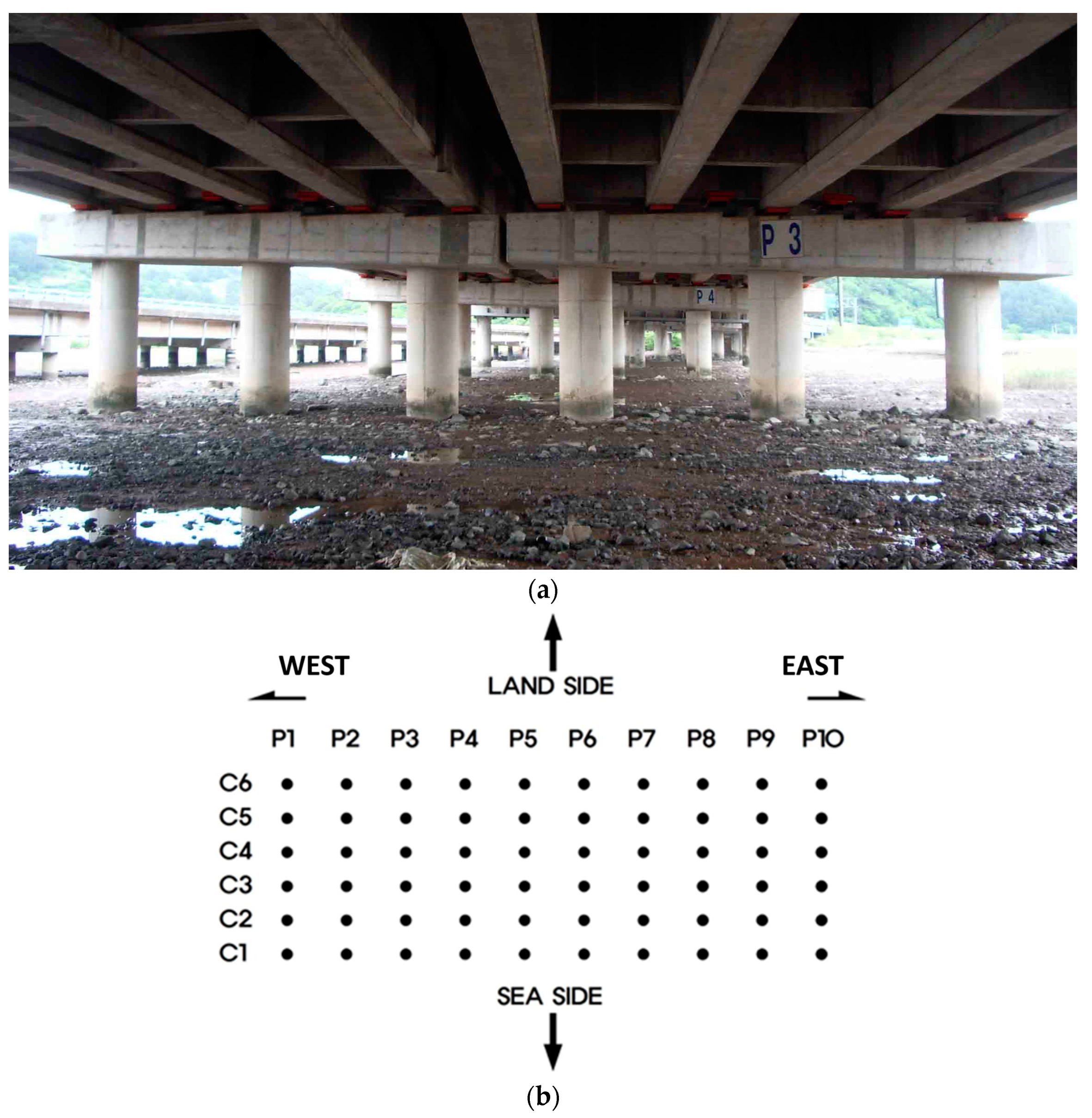
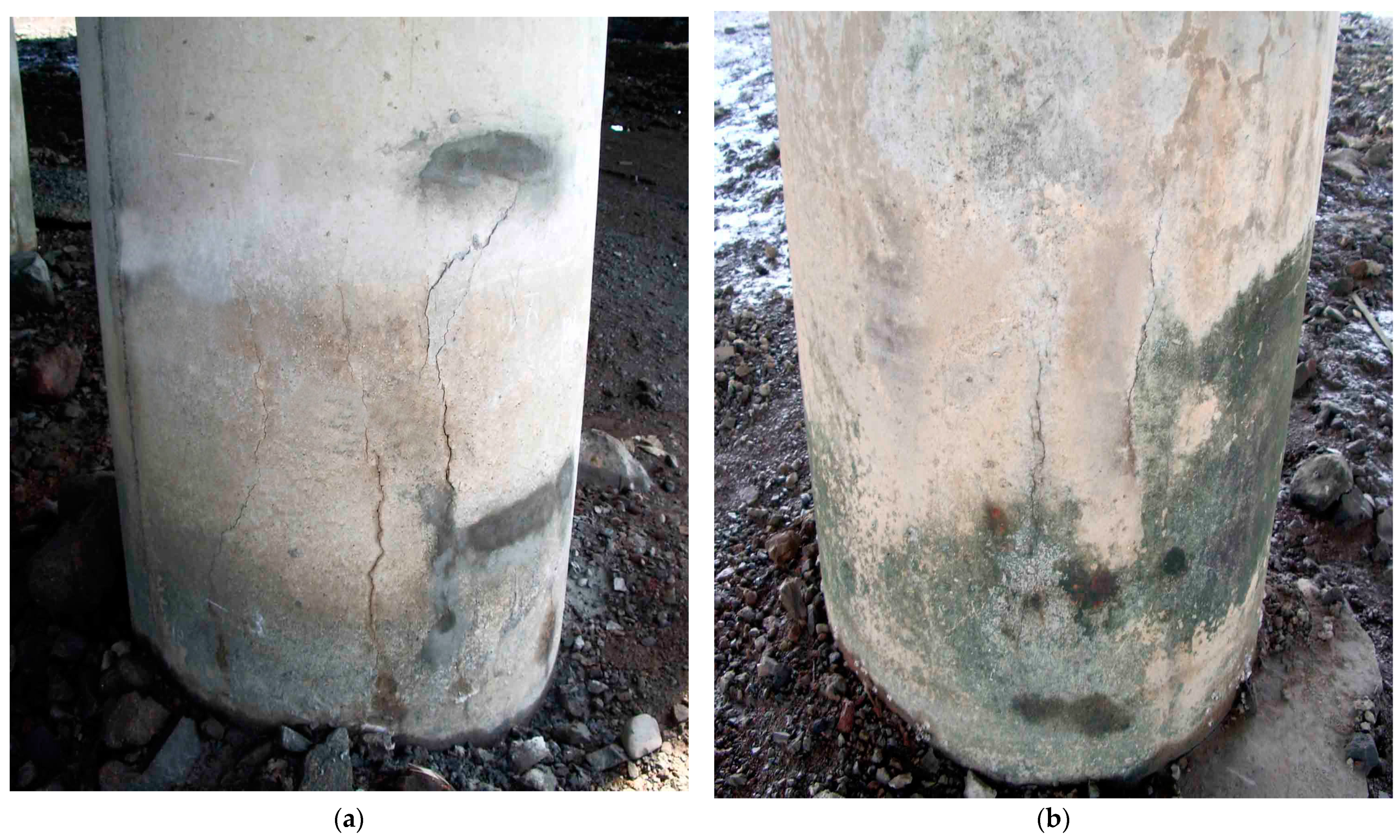
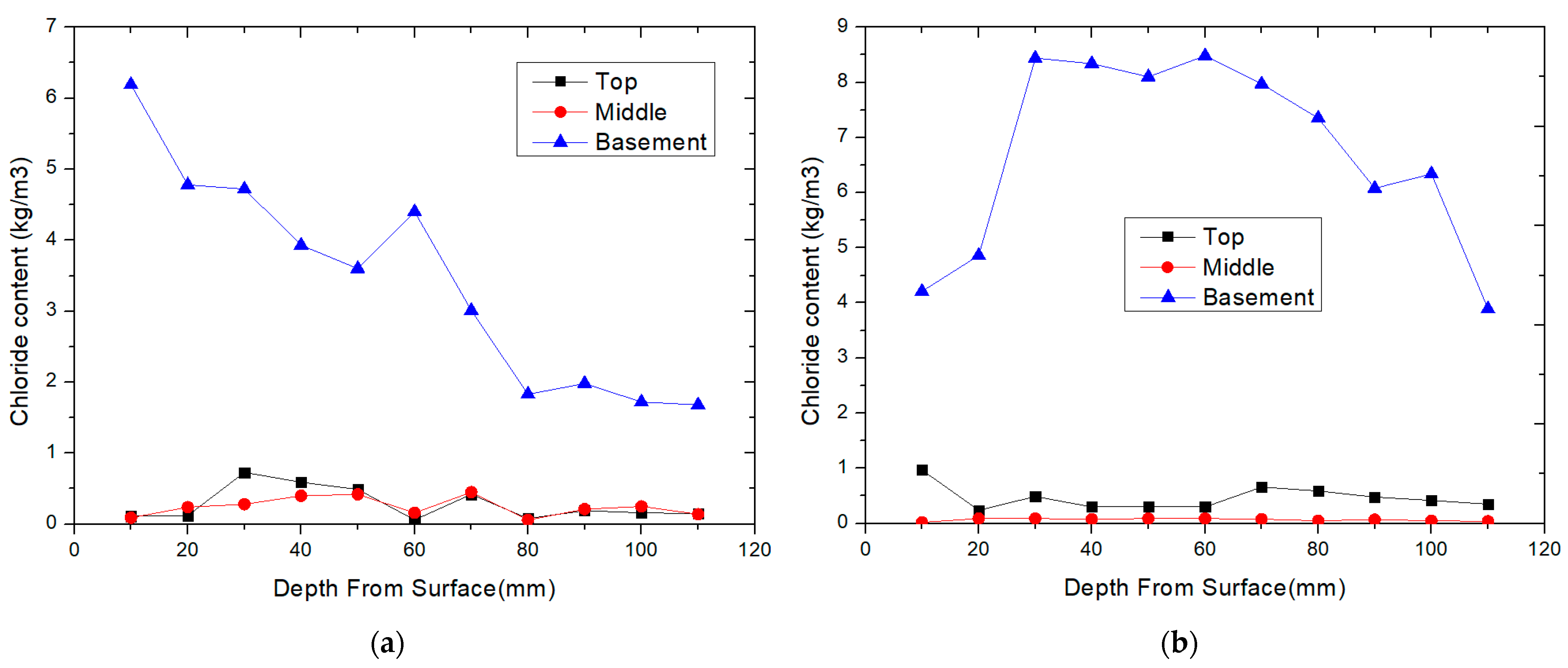
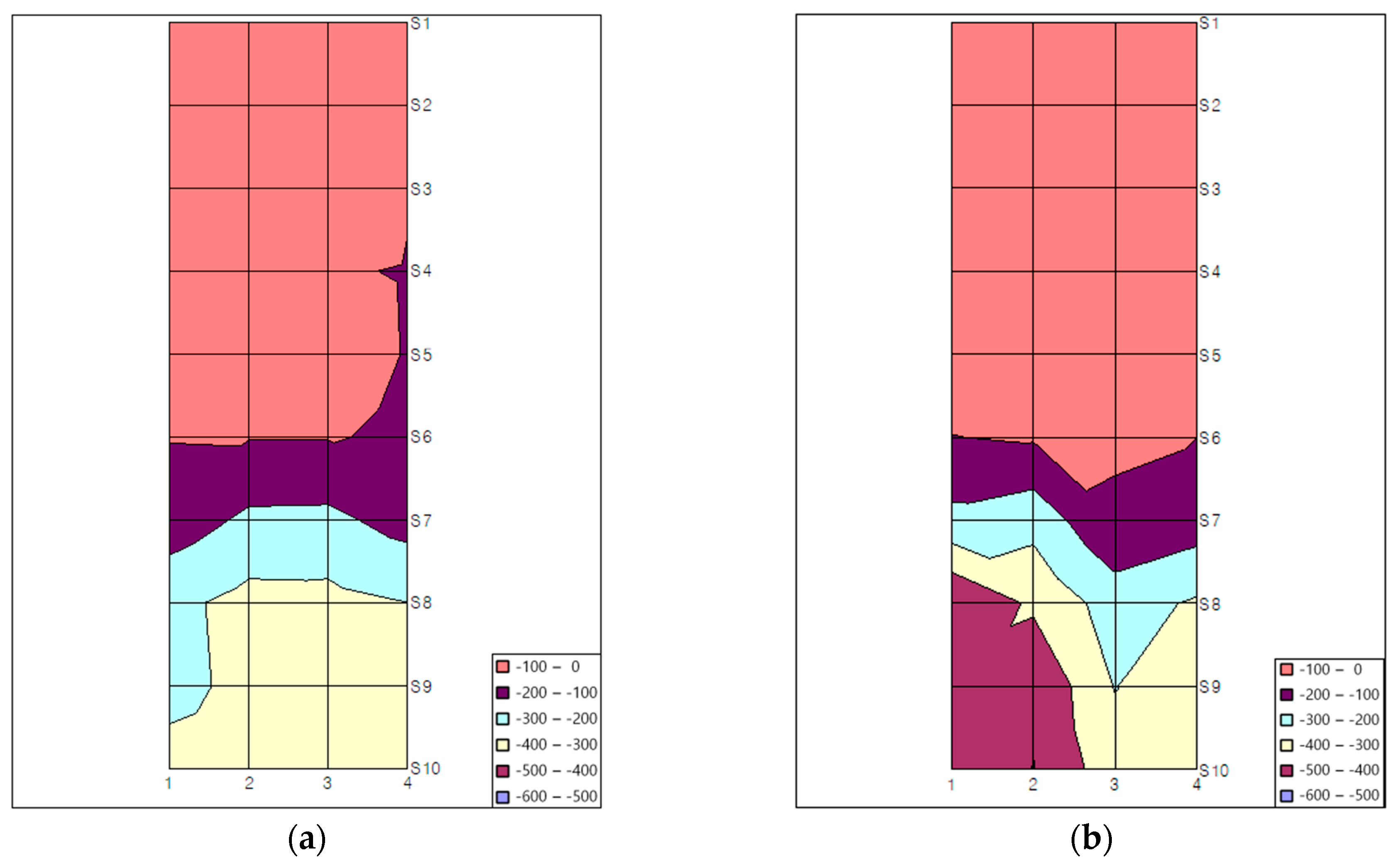
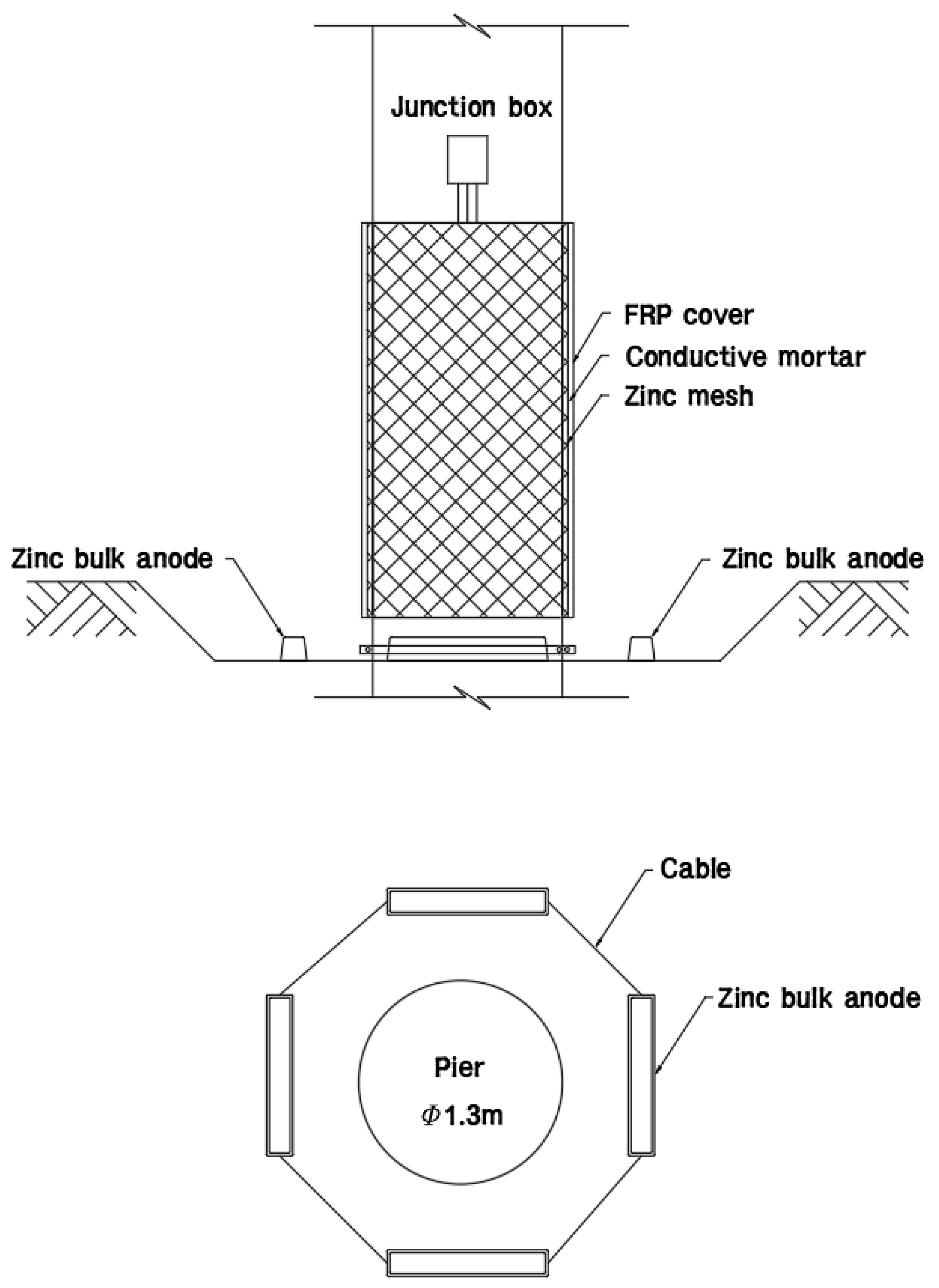

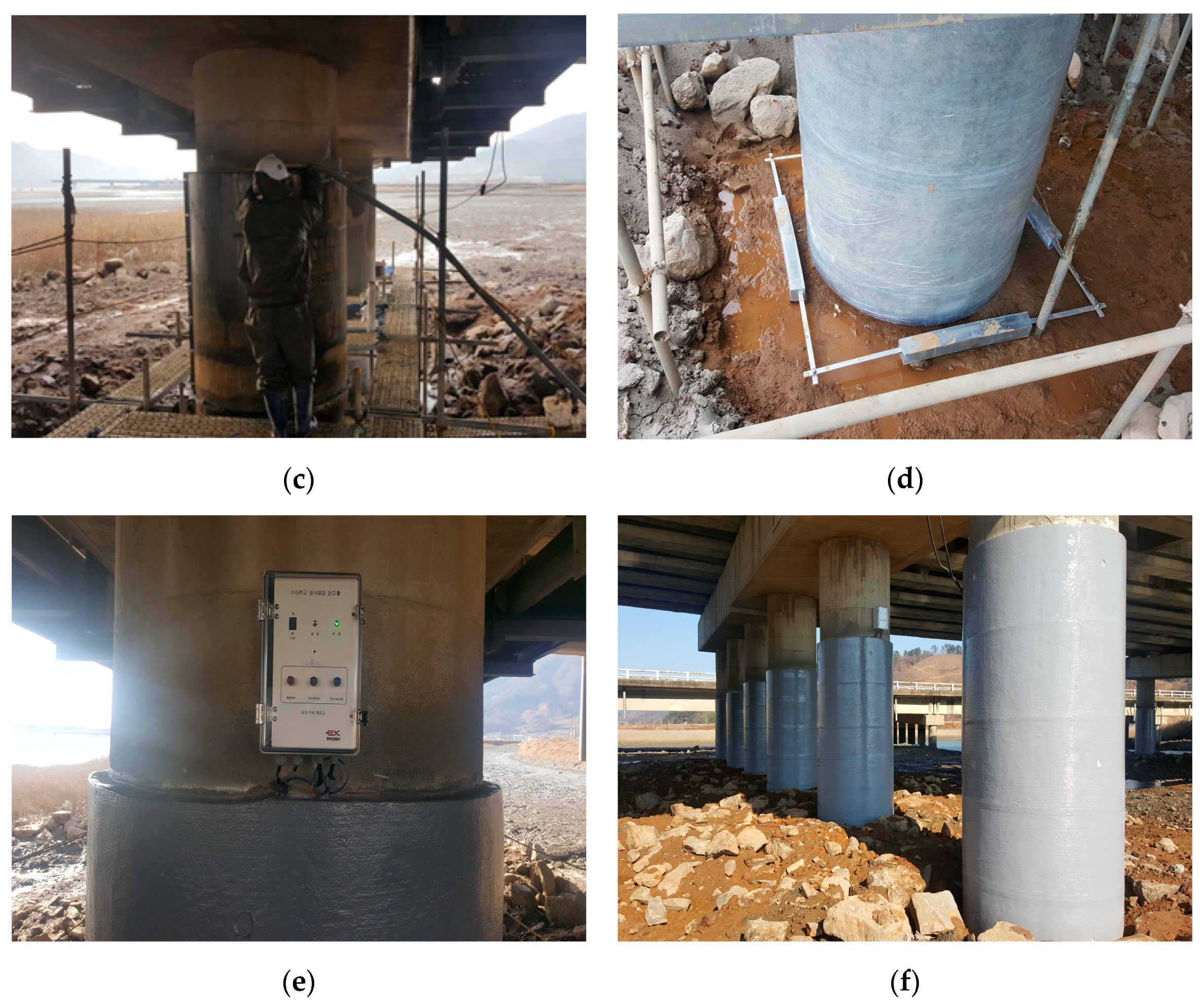

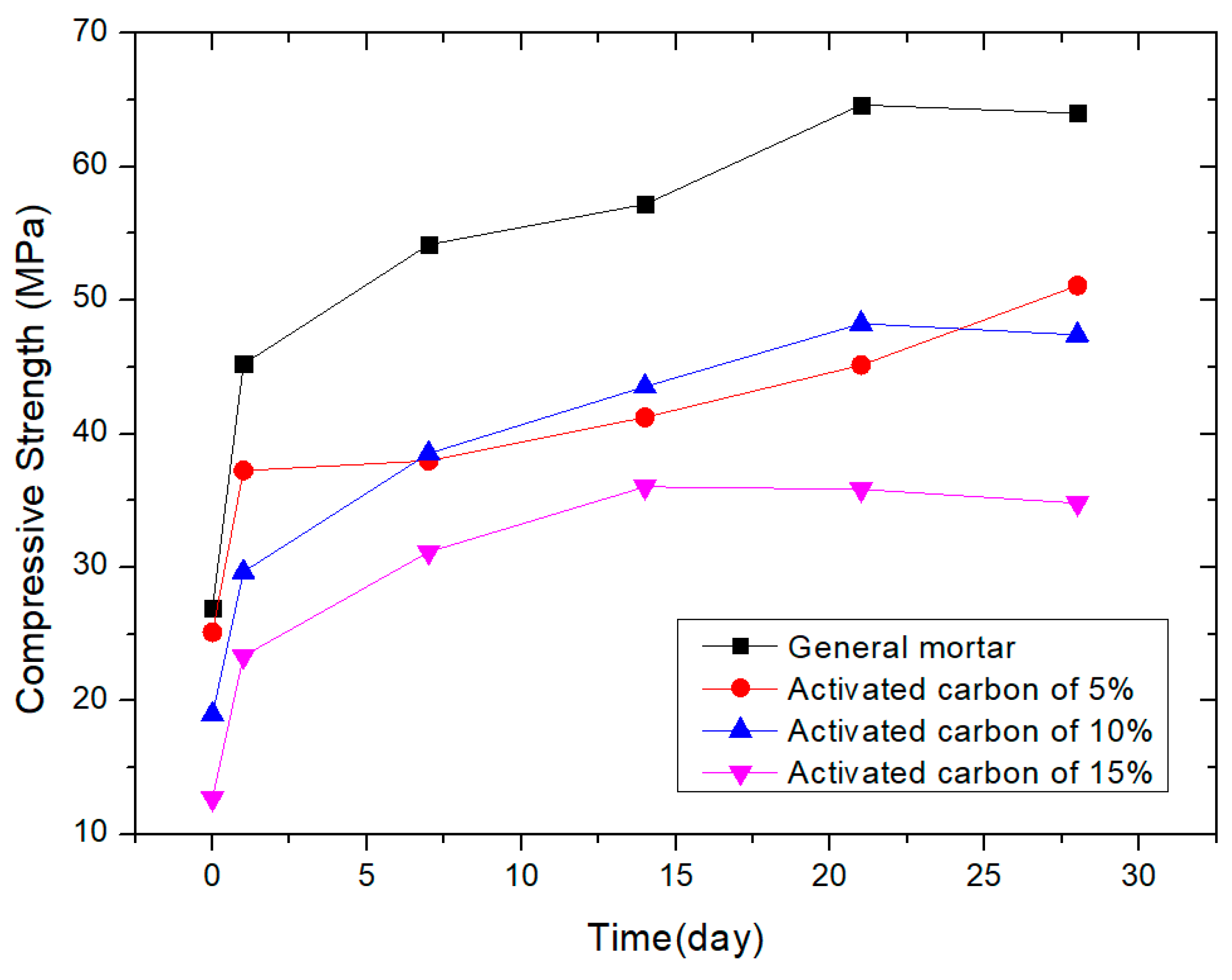
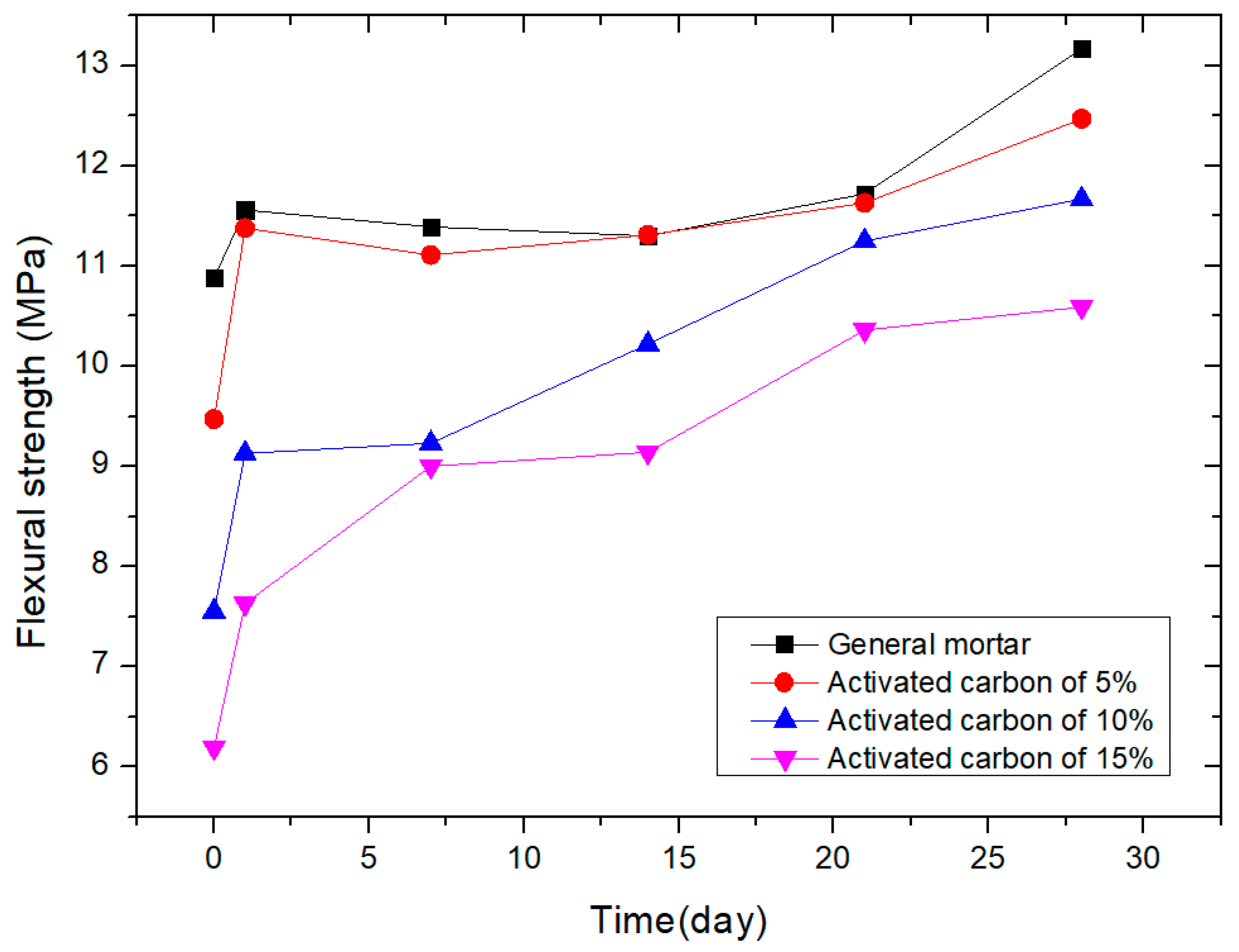


| Activated Carbon Mix Design (OPC/S = 1.45) | ||||
|---|---|---|---|---|
| Admixture Ratio: 0% | Admixture Ratio: 5% | |||
| Material | Weight (g) | Percentage by Volume (%) | Weight (g) | Percentage by Volume (%) |
| Cement | 348.46 | 85.28 | 348.46 | 85.28 |
| α-gypsum hemihydrate | 4.73 | 1.16 | 4.73 | 1.16 |
| Expansion agent | 15.76 | 3.86 | 15.76 | 3.86 |
| LI-T | 2.24 | 0.55 | 2.24 | 0.55 |
| Latex resin | 6.31 | 1.54 | 6.31 | 1.54 |
| Silica fume | 28.57 | 6.99 | 28.57 | 6.99 |
| Polycarboxylic acid-based polymer | 1.13 | 0.28 | 1.13 | 0.28 |
| PVA | 1.22 | 0.3 | 1.22 | 0.3 |
| Dispersing agent | 0.16 | 0.04 | 0.16 | 0.04 |
| Air-entraining agent | 0.03 | 0.01 | 0.03 | 0.01 |
| Total powder | 408.61 | 100 | 408.61 | 100 |
| Sand #5 | 116 | 19.59 | 116 | 19.59 |
| Sand #6 | 476 | 80.41 | 446.4 | 75.41 |
| Activated carbon | 0 | 0 | 29.6 | 5.00 |
| Total sand | 592 | 100 | 592 | 100 |
| Mortar | 1000 | 100 | 1000 | 100 |
| Water | 180 | 18 | 180 | 18 |
| Total | 1800 | - | 1000 | - |
| Item | Unit | Test Results | Quality Standards |
|---|---|---|---|
| Flexural strength | N/mm2 | 6.50 | 6.0 or more |
| Compression strength | N/mm2 | 42.10 | 20.0 or more |
| Bonding strength (standard condition) | N/mm2 | 2.30 | 1.0 or more |
| Bonding strength (after repeating warming and cooling) | N/mm2 | 1.60 | 1.0 or more |
| Permeability quantities | g | 6.30 | 20.0 or less |
| Water absorption coefficient | kg/m2h0.5 | 0.09 | 0.5 or less |
| Moisture permeation resistance | m | 1.00 | 2.0 or less |
| Length variation ratio | % | −0.08 | within ±0.15 |
| Period | P2C2 | P2C1 | P3C1 | P4C5 | P7C1 | P8C3 | P8C1 | |
|---|---|---|---|---|---|---|---|---|
| Before using conductive mortar | 10 | 173 | 10 | 31 | 31 | 10 | 10 | |
| After using conductive mortar | 1 month | 150 | 155 | 177 | 158 | 195 | 103 | 160 |
| 6 months | 146 | 102 | 187 | 144 | 79 | 130 | 91 | |
| 12 months | 210 | 150 | 165 | 122 | 133 | 123 | 112 | |
| 18 months | 108 | 70 | 126 | 115 | 112 | 118 | 155 | |
| 24 months | 75 | 72 | 205 | 136 | 109 | 208 | 72 | |
| 36 months | 60 | 52 | 145 | 82 | 117 | 220 | 102 | |
| 49 months | 65 | 50 | 181 | 88 | 108 | 250 | 122 | |
Disclaimer/Publisher’s Note: The statements, opinions and data contained in all publications are solely those of the individual author(s) and contributor(s) and not of MDPI and/or the editor(s). MDPI and/or the editor(s) disclaim responsibility for any injury to people or property resulting from any ideas, methods, instructions or products referred to in the content. |
© 2024 by the authors. Licensee MDPI, Basel, Switzerland. This article is an open access article distributed under the terms and conditions of the Creative Commons Attribution (CC BY) license (https://creativecommons.org/licenses/by/4.0/).
Share and Cite
Ha, J.-M.; Jeong, J.-A.; Jin, C. Development of Conductive Mortar for Efficient Sacrificial Anode Cathodic Protection of Reinforced Concrete Structures—Part 2: Four-Year Performance Evaluation in Bridges. Appl. Sci. 2024, 14, 1797. https://doi.org/10.3390/app14051797
Ha J-M, Jeong J-A, Jin C. Development of Conductive Mortar for Efficient Sacrificial Anode Cathodic Protection of Reinforced Concrete Structures—Part 2: Four-Year Performance Evaluation in Bridges. Applied Sciences. 2024; 14(5):1797. https://doi.org/10.3390/app14051797
Chicago/Turabian StyleHa, Ji-Myung, Jin-A Jeong, and Chungkuk Jin. 2024. "Development of Conductive Mortar for Efficient Sacrificial Anode Cathodic Protection of Reinforced Concrete Structures—Part 2: Four-Year Performance Evaluation in Bridges" Applied Sciences 14, no. 5: 1797. https://doi.org/10.3390/app14051797





